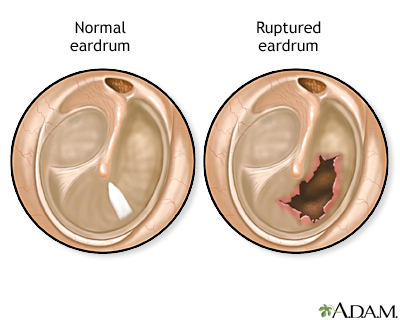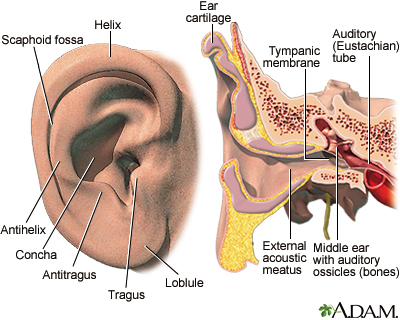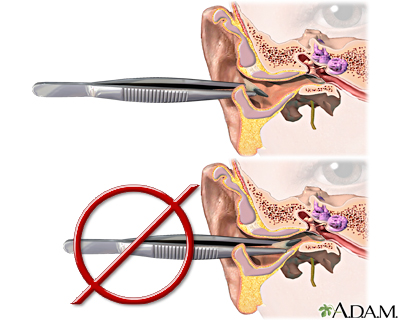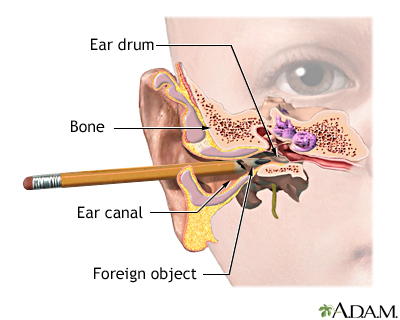Health Library
Ear emergencies
Ear emergencies include objects in the ear canal, ruptured eardrums, sudden hearing loss, and severe infections.
Images




I Would Like to Learn About:
Considerations
Children often put objects into their ears. These objects can be hard to remove. The ear canal is a tube of solid bone that is lined with thin, sensitive skin. Any object pressing against the skin can be very painful. In many cases, a health care provider will need to use special instruments to examine the ear and safely remove the object.
Causes
Pain, hearing loss, dizziness, ringing in the ear, and ruptured eardrums can be caused by:
- Inserting cotton swabs, toothpicks, pins, pens, or other objects into the ear
- Sudden changes in pressure, as from an explosion, blow to the head, flying, scuba diving, falling while water skiing, or being slapped on the head or ear
- Loud sounds, such as a gun firing
- Inflammation of the inner or middle ear
Symptoms
Symptoms include:
- Bleeding from the ear
- Bruising or redness
- Clear liquid coming out of the ear (brain fluid)
- Dizziness
- Earache
- Loss of hearing
- Nausea and vomiting
- Noises in the ear
- Sensations of an object in the ear
- Swelling
- Visible object in the ear
- Fever
- Hearing loss
First Aid
Depending on the type of ear emergency, follow the steps below.
OBJECT IN THE EAR
Calm and reassure the person.
- If the object is sticking out and is easy to remove, gently remove it by hand or with tweezers. Then, get medical help to make sure the entire object has been removed.
- If you think a small object may be lodged inside the ear, but you cannot see it, DO NOT reach inside the ear canal with tweezers. You can do more harm than good.
- Try using gravity to get the object out by tilting the head to the affected side. DO NOT strike the person's head. Shake it gently in the direction of the ground to try to dislodge the object.
- If the object does not come out, get medical help.
INSECT IN THE EAR
DO NOT let the person put a finger in the ear. This may make the insect sting.
- Turn the person's head so that the affected side is up and wait to see if the insect flies or crawls out.
- If this does not work, try pouring mineral oil, olive oil, or baby oil into the ear. For an adult, pull the ear lobe gently backward and upward as you pour the oil. For a child, pull the ear lobe backward and downward as you pour. The insect should suffocate and may float out in the oil. AVOID using oil to remove any object other than an insect, since oil can cause other types of foreign objects to swell.
- Even if an insect appears to come out, get medical attention. Small insect parts can irritate the sensitive skin of the ear canal.
RUPTURED EARDRUM
The person will have severe pain.
- Place sterile cotton gently in the outer ear canal to keep the inside of the ear clean.
- Get medical help.
- Do not put any liquid into the ear.
CUTS ON THE OUTER EAR
Apply direct pressure until the bleeding stops.
- Cover the injury with a sterile dressing shaped to the contour of the ear, and tape it loosely in place.
- Apply cold compresses over the dressing to reduce pain and swelling.
- If part of the ear has been cut off, keep the part. Get medical help right away.
- Place the part in a clean cloth and keep it on ice.
DRAINAGE FROM INSIDE THE EAR
Cover the outside of the ear with a sterile dressing shaped to the contour of the ear, and tape it loosely in place.
- Have the person lie down on the side with the affected ear down so that it can drain. However, DO NOT move the person if a neck or back injury is suspected.
- Get medical help right away.
Do Not
If someone has an ear emergency, remember the following:
- DO NOT block any drainage coming from the ear.
- DO NOT try to clean or wash the inside of the ear canal.
- DO NOT put any liquid into the ear.
- DO NOT attempt to remove the object by probing with a cotton swab, a pin, or any other tool. To do so will risk pushing the object farther into the ear and damaging the middle ear.
- DO NOT reach inside the ear canal with tweezers.
When to Contact a Medical Professional
Some symptoms may mean you have had serious injury to your ear. See a provider if you have:
- Pain in the ear
- Ringing sounds
- Dizziness (vertigo)
- Hearing loss
- Drainage or blood from the ear
- Recent blow to your ear or head
Prevention
Follow these steps to prevent ear emergencies:
- Never put anything in the ear canal without first talking to a provider.
- Never hit the head to try to correct an ear problem.
- Teach children not to put things in their ears.
- Avoid cleaning the ear canals altogether.
- After an ear injury, avoid nose blowing and getting water in the injured ear.
- Treat ear infections right away.
If you tend to feel pain and pressure in your ears when flying:
- Drink a lot of fluid before and during the flight.
- Avoid the use of alcohol, caffeine, or tobacco on the day of the flight.
- Chew gum, suck on hard candy, or yawn during take-off and landing.
- Talk to your provider about taking a decongestant or using a nasal spray before you fly.
Related Information
Acoustic traumaReferences
Goodloe JM, Skoulek J. Foreign bodies. In: Walls RM, Hockberger RS, Gausche-Hill M, eds. Rosen's Emergency Medicine: Concepts and Clinical Practice. 10th ed. Philadelphia, PA: Elsevier; 2023:chap 51.
Matlock AG, Pfaff JA. Otolaryngology. In: Walls RM, Hockberger RS, Gausche-Hill M, eds. Rosen's Emergency Medicine: Concepts and Clinical Practice. 10th ed. Philadelphia, PA: Elsevier; 2023:chap 58.
BACK TO TOPReview Date: 5/30/2022
Reviewed By: Josef Shargorodsky, MD, MPH, Johns Hopkins University School of Medicine, Baltimore, MD. Also reviewed by David C. Dugdale, MD, Medical Director, Brenda Conaway, Editorial Director, and the A.D.A.M. Editorial team.
 | A.D.A.M., Inc. is accredited by URAC, for Health Content Provider (www.urac.org). URAC's accreditation program is an independent audit to verify that A.D.A.M. follows rigorous standards of quality and accountability. A.D.A.M. is among the first to achieve this important distinction for online health information and services. Learn more about A.D.A.M.'s editorial policy, editorial process and privacy policy. A.D.A.M. is also a founding member of Hi-Ethics. This site complies with the HONcode standard for trustworthy health information: verify here. |
The information provided herein should not be used during any medical emergency or for the diagnosis or treatment of any medical condition. A licensed medical professional should be consulted for diagnosis and treatment of any and all medical conditions. Links to other sites are provided for information only -- they do not constitute endorsements of those other sites. © 1997- 2022 A.D.A.M., a business unit of Ebix, Inc. Any duplication or distribution of the information contained herein is strictly prohibited.
